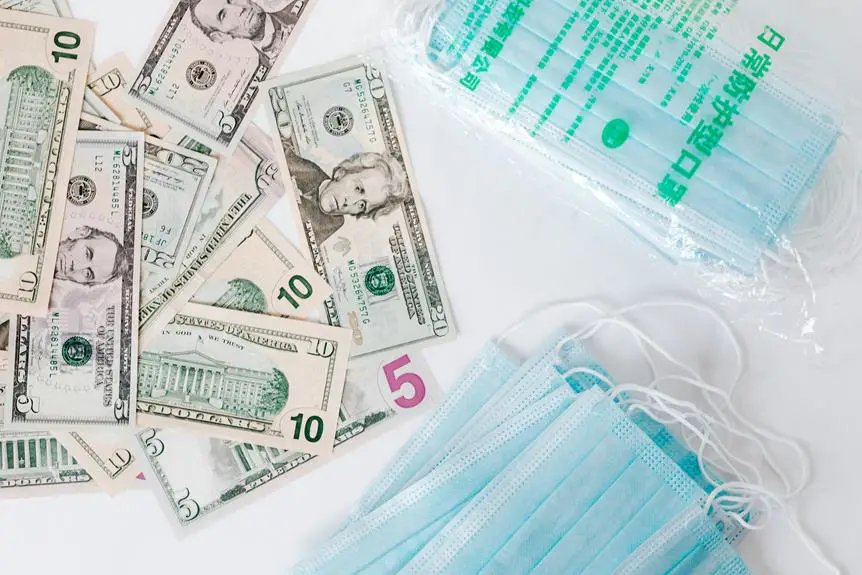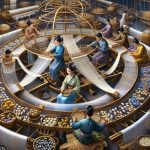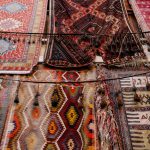When you consider the economic impact of brocade production, it's clear that this ancient craft does more than just create beautiful textiles. It generates jobs for skilled artisans and supports a network of local businesses, from raw silk suppliers to tailoring shops. You might be surprised to learn how deeply intertwined this industry is with community development and cultural preservation. Yet, despite its significance, brocade production faces various challenges that could threaten its future. What are these challenges, and how might they reshape the industry?
Table of Contents
Historical Significance of Brocade
Brocade has long held a prominent place in history, symbolizing wealth and status across various cultures and eras. You can trace its roots back to ancient civilizations, where it adorned the garments of royalty and the elite. In China, brocade became a revered art form, crafted from silk and often woven with intricate patterns that told stories of mythology and heritage.
As you explore its journey, you'll notice how it transcended borders, influencing fashion in the Byzantine Empire and later making waves in Europe during the Renaissance.
You might find it fascinating that brocade wasn't just a fabric; it was a statement. It represented the economic power of nations, with trade routes established to supply this luxurious material. The craftsmanship required to produce brocade meant it was often reserved for special occasions and important ceremonies.
When you think about the cultural significance, remember how it shaped traditions and inspired artists across generations. Today, brocade continues to echo its historical roots, reminding you of its rich legacy while still being celebrated in modern fashion.
This enduring appeal highlights the timeless allure of brocade as an emblem of elegance and prestige.
Job Creation and Employment Opportunities
The rich history of brocade not only highlights its cultural significance but also underscores its role in generating job creation and employment opportunities in various sectors.
When you consider brocade production, you'll see it involves a diverse range of skilled artisans, weavers, and designers who contribute to this intricate craft. This demand for skilled labor leads to job openings in textile manufacturing, where you can find positions for both experienced craftsmen and newcomers eager to learn.
Moreover, the supply chain for brocade production creates additional employment opportunities. From raw silk producers to dyeing facilities, each step in the process requires a workforce.
Local communities often benefit from these jobs, as they help sustain families and uplift the economy. Not to mention, the rise of brocade in fashion and home décor markets opens doors for marketing, sales, and distribution roles.
Contribution to Local Economies
Artisans and local businesses thrive as brocade production injects vital resources into community economies. When you support brocade makers, you're not just purchasing a product; you're fueling a network of local suppliers and services. This craft creates demand for raw materials like silk and cotton, which encourages farmers to grow these crops, boosting agricultural income.
Your investment in brocade also enhances income for weavers and artisans. Many of them rely on brocade weaving as their primary source of livelihood. As they earn a fair wage, they can spend more on local goods and services, further energizing the economy. This cycle promotes a sense of community and shared prosperity.
Moreover, brocade production often leads to the establishment of small businesses, such as dye houses or tailoring shops, which offer additional employment opportunities. You'll find that these local enterprises foster innovation and creativity, making your community a vibrant cultural hub.
Cultural Preservation and Heritage
Crafting brocade weaves a rich tapestry of cultural heritage, preserving age-old techniques and traditions for future generations. When you engage with this intricate art form, you're not just creating beautiful textiles; you're also keeping the stories and identities of communities alive. Each pattern and color has significance, often reflecting local myths, folklore, and social statuses.
As you learn the skills required for brocade weaving, you're also participating in a communal activity that strengthens bonds among artisans. This shared knowledge fosters a sense of belonging and pride, connecting you to your ancestors. By choosing to support brocade artisans, you help safeguard these traditions against the erosion of modernity.
Moreover, brocade serves as a medium for cultural expression, showcasing the unique identity of various regions. When you wear or display brocade, you're not just appreciating its beauty; you're also honoring the rich histories and cultural narratives embedded within each piece.
This practice of cultural preservation is vital for sustaining diversity in our fast-paced world, ensuring that future generations can appreciate and understand their heritage. Thus, investing in brocade production is more than an economic choice; it's a commitment to preserving cultural identity.
Challenges Facing Brocade Artisans
While preserving cultural heritage through brocade is vital, artisans face significant challenges that threaten their craft and livelihood. You mightn't realize how many issues these skilled individuals confront daily.
Here are three key challenges:
- Competition from Mass Production: With cheaper, machine-made alternatives flooding the market, many artisans struggle to compete. Customers often opt for lower-priced items, making it hard for traditional artisans to sustain their businesses.
- Access to Resources: Quality materials for brocade production can be hard to find. Artisans sometimes face shortages of silk or specialized threads, which impacts the quality of their work and limits their creative expression.
- Market Awareness: Many consumers aren't aware of the time and skill involved in creating authentic brocade. This lack of appreciation can lead to undervaluation, making it tough for artisans to price their work fairly.
These challenges not only affect individual artisans but also threaten the entire craft's survival. To ensure the future of brocade production, it's crucial to support these artisans and raise awareness about their invaluable contributions to culture and economy.
Frequently Asked Questions
What Are the Environmental Effects of Brocade Production?
When you consider brocade production, you'll notice environmental effects like water pollution from dyeing processes, deforestation for raw materials, and increased carbon emissions. Sustainable practices can help mitigate these impacts, promoting a healthier ecosystem.
How Do Modern Technologies Influence Brocade Weaving Techniques?
Modern technologies enhance brocade weaving techniques by introducing automated looms and digital design tools. You'll see improved efficiency, intricate patterns, and reduced labor costs, allowing artisans to focus on creativity and innovation in their craft.
What Are the Primary Markets for Brocade Products Today?
You'll find brocade products primarily in high-end fashion, home textiles, and upholstery markets. Designers and consumers appreciate its luxurious texture, which drives demand in both traditional and contemporary styles across various regions worldwide.
How Does Brocade Compare to Other Textiles Economically?
Brocade's unique texture and artistry often command higher prices compared to other textiles. While cheaper options exist, its luxury appeal allows you to tap into niche markets, making it economically viable for specialty producers.
What Role Do International Trade Agreements Play in Brocade Production?
International trade agreements can significantly influence brocade production. They lower tariffs, enhance market access, and encourage collaboration. By understanding these agreements, you can better navigate the global textile landscape and leverage opportunities for your business.
- Dyeing Synthetics: Is Polyester or Polyamide Easier to Dye? - June 30, 2025
- How to Waterproof a Cotton-Polyamide Blend Fabric - June 30, 2025
- How to Properly Wash 80/20 Polyester-Polyamide Blends - June 30, 2025







